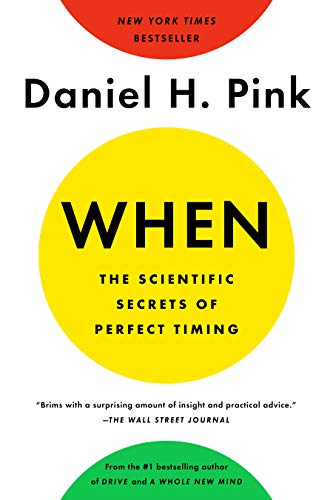When: The Scientific Secrets of Perfect Timing by Daniel H. Pink Link to heading
Summary Link to heading
“When: The Scientific Secrets of Perfect Timing” by Daniel H. Pink explores the science of timing in our lives. Drawing on a vast array of research from fields such as psychology, biology, and economics, Pink presents a framework for understanding how timing affects our everyday lives and decisions. The book covers various aspects of timing, such as the importance of beginnings, midpoints, and endings in our day-to-day activities and long-term projects. Pink offers strategies and tips on how to make the best of different times of the day and presents insights into why timing is a crucial element to productivity, decision-making, and personal fulfillment.
Review Link to heading
Daniel H. Pink’s “When” has been praised for its accessible writing style and ability to distill complex research into practical advice. The book is impactful because it challenges the reader to rethink commonly held beliefs about timing and offers evidence-based techniques for optimizing it. One of its strengths is the diverse research base that Pink uses to validate his suggestions, providing a robust and credible foundation for his claims. However, some critiques point out that certain conclusions can be generalized, and the reliance on studies might not always account for individual variability.
Key Takeaways Link to heading
- Chronotypes Matter: Understanding your biological clock or chronotype can help optimize productivity by aligning tasks with the natural peaks and troughs of energy levels during the day.
- The Power of Breaks: Regular breaks can rejuvenate mental acuity and maintain performance levels, emphasizing the importance of planned and restorative pauses in the day.
- Strategic Timing: Timing can affect decisions and outcomes in significant ways, such as the influence of beginning times, midpoint slumps, and the motivational push of approaching deadlines or endings.
- Harnessing Start and Restarts: Starting new projects or resetting goals at specific “temporal landmarks” (like birthdays or the start of a week) can enhance our likelihood of success.
- The “Nappuccino” Technique: A tactical approach to napping that involves drinking a cup of coffee immediately before a short nap, allowing caffeine to kick in as you wake up, boosting alertness.
Recommendation Link to heading
“When: The Scientific Secrets of Perfect Timing” is highly recommended for individuals looking to optimize their productivity, decision-making, and personal lives by understanding and leveraging the science of timing. Professionals, students, and anyone interested in self-improvement can benefit from the actionable insights and easy-to-understand explanations that Pink provides.
